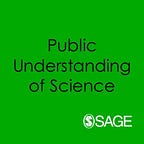Culture, curiosity and communication in scientific discovery: the eye in ideas
Review by Maarten van der Sanden
“Science communication and understanding is not just the delivery of a message but is an essential aspect of science”
As it is described in the preface, this concise book considers how meaning is created in science and the part that questions and questioning play in the development of scientific theories. Sanitt takes the reader by the hand on how questions are raised and dealt with, mostly in the realm of physics. He shows the importance of ethics, art, history and communication in 16 clear and concise chapters. Moreover, he describes thoughtfully the importance and development of inter- and transdisciplinarity and the educational process alike.
These dimensions are unavoidable in a complex world, in which the dynamic of science as a socio-technical system should be a starting point for science communication. This system contains the continuum between the early onset of ideas and their applications in society. Sanitt writes: “First, scientists communicate not only with the public and other groups outside science, but also with each other. Second, the levels of communication within science involve not only collaborators and colleagues but also involve scientists in allied or even remote disciplines when there are multi- or interdisciplinary research projects. Third, there is communication from governments, lawmakers, grant-awarding bodies and other organizations as well as the public to scientists. Such communication may filter, modify, encourage or even curtail scientific research”.
Nigel Sanitt is a physicist-astronomer who helped to lay the foundations of gravitational lensing research. Besides that he is editor of the online journal Pantaneto Forum, which is devoted to science communication. Moreover, Sanitt writes novels using his alias Norman Stanton. This CV and the presumed skills raises expectations that are certainly met in relation to writing style, but the book does not make a clear choice between descriptive presentation of important issues that come with doing science and scientific research, a well thought-out essay on how he as a scientist and science writer sees all this, and a polemical piece of writing. All three are valuable, but a clear choice for one of these aims would have given the book a stronger focus.
The book starts with scientific theories, how they come to exist, mainly in natural sciences, more specifically astronomy, and introduces scientific development as a network, a system of theories and thoughts that come together at a certain point in time. This is explained in chapters on ‘Networks’ and ‘Graph theory’. These early chapters offer insights for science communication researchers and practitioners, since it is important to know that science is a network of people working and thinking together and who, consciously or unconsciously, add to the network of scientific development.
In the second part of the book, Sanitt reflects on the connections between science and literature, religion, art, history, complexity and culture, ethics, mathematics and AI and education. From this point the book slowly but certainly moves into a critique of the way science is embedded in society and its sometimes flawed scientific and science communication endeavours. Sanitt adopts more and more powerful stances like: “Prejudices, unfortunately, are still present and it is still the case that academics who work in more than one discipline have a harder time in advancing their career”.
Sanitt also writes — and I could not agree more — that science communication should be a ‘trail blazer’ for the development of science and society: “Critical thinking leads to better communication in science. Science communication and understanding is not just the delivery of a message but is an essential aspect of science: it is not just painted on after the science is finished. Neither should science be seen as a problem that needs a solution”.
The ‘grande finale’ of the book, ‘Summary: the new Atlantis’, is mostly a summary and does not realise the ambition stated at the start of the chapter “to bring all the threads together in a unified way”. Sanitt does bring some threads together, but the new Atlantis is still covered by water. So, this is a good, resourceful read, but I’m still curious about how Sanitt imagines the new Atlantis. He might apply his novelist qualities to this.
Maarten van der Sanden, is associate professor in Communication Design for Innovation at the Delft University of Technology, The Netherlands. His recent publications include (with A. Lagendijk, B. Hillebrand, E. Kalmar and I. Van Marion) Blockchain innovation and framing in the Netherlands: how a technological object turns into a ‘hyperobject’, Technology in Society, https://doi.org/10.1016/j.techsoc.2019.101175
